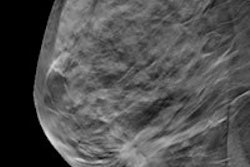
The clinical performance of radiologists improves when digital breast tomosynthesis (DBT) is combined with conventional 2D full-field digital mammography (FFDM) for breast cancer screening, according to research published in the September issue of Academic Radiology.
Specifically, radiologists have lower recall rates and their cancer detection rates are higher when both technologies are used, concluded lead author Dr. Stephen Rose, of the TOPS Comprehensive Breast Center in Houston, and colleagues.
 Dr. Stephen Rose from TOPS Comprehensive Breast Center.
Dr. Stephen Rose from TOPS Comprehensive Breast Center."The use of DBT in the screening environment has a fundamental and significant impact on performance," they wrote. "Clearly, none of the technologies used for screening to date is perfect, nor is FFDM + DBT. However, the consistency in our findings for the group as a whole and for each of the individual radiologists is quite encouraging" (Acad Radiol, September 2014, Vol. 21:9, pp. 1204-1210).
The study included 10,878 screening exams conducted between May 2011 and January 2012 with both tomosynthesis and FFDM. Rose and colleagues analyzed the recall and cancer detection rates of seven radiologists who performed retrospective readings of FFDM exams, and they compared the results with recall and detection rates of 10 radiologists who originally interpreted the FFDM plus DBT exams.
The seven readers of FFDM alone were blinded to the BI-RADS category given during the clinical interpretations and the confirmed outcome as determined by follow-up.
All of the radiologists who participated in the study were experienced breast imagers, with an average of 12 years of mammography interpretation experience (range, 2-32 years), according to the researchers.
The TOPS Comprehensive Breast Center has a relatively stable screening population, of which 15% to 20% are new patients, Rose and colleagues wrote. During the study time frame, 88% of the center's patients had the combined FFDM-DBT exam, because the center implemented DBT in a staggered manner starting in 2011. Women received DBT based on its availability that day and the availability of qualified technical staff, rather than their age, known breast density, or other risk factors.
| Performance of DBT + FFDM vs. FFDM alone | ||
| FFDM | DBT + FFDM | |
| Recall rate | 8.2% | 5.4% |
| Cancer detection per 1,000 cases | 3.5 cancers | 5.4 cancers |
| Total invasive cancers found | 29 | 48 |
Of the 10,878 FFDM plus DBT cases interpreted, 588 (5.4%) were recalled, compared with 888 (8.2%) of the retrospective FFDM-only cases.
"The recall rate for all screened women undergoing FFDM only during this period and interpreted by any radiologist in our practice was 7%," Rose's team wrote.
Overall cancer detection rates were 5.4 per 1,000 for the DBT plus FFDM interpretations and 3.5 per 1,000 for the FFDM-only interpretations. The cancer detection rate for all screened women who had FFDM only during this period that was interpreted by any radiologist in the practice was 2.9 per 1,000 screens, according to Rose and colleagues. Also, the FFDM-DBT combination found more invasive cancers than FFDM alone, at 48 versus 29.
Adding DBT to FFDM is effective, the authors concluded.
"We believe that the findings of our study add yet another layer of confidence that the use of DBT indeed has a significant positive impact on radiologist screening performance," they wrote.




















